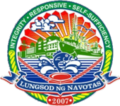This article needs additional citations for verification .(December 2012) |
Navotas | |
|---|---|
Clockwise starting from the top: Aerial view of Navotas, Diocesan Shrine and Parish of San Jose de Navotas, Navotas City Hall, Omaghicon Monument, Navotas Agora Complex, Navotas Fish Port Complex | |
| Nickname: Commercial Fishing Hub of the Philippines | |
| Motto: Itaas ang antas ng Buhay-Navoteño (Raise the Level of the Navoteño Life) | |
| Anthem: Himno ng Navotas; English: Navotas Hymn | |
 Map of Metro Manila with Navotas highlighted | |
 Interactive map of Navotas | |
Location within the Philippines | |
| Coordinates: 14°40′00″N120°56′30″E / 14.6667°N 120.9417°E | |
| Country | Philippines |
| Region | National Capital Region |
| Province | none |
| District | Lone district |
| Founded | February 16, 1859 |
| Annexation to Malabon | October 12, 1903 |
| Chartered | January 16, 1906 |
| Cityhood and HUC | June 24, 2007 |
| Barangays | 18 (see Barangays) |
| Government | |
| • Type | Sangguniang Panlungsod |
| • Mayor | John Reynald M. Tiangco (NVTEÑO) |
| • Vice Mayor | Tito M. Sanchez (NVTEÑO) |
| • Representative | Tobias Reynald M. Tiangco (NVTEÑO) |
| • Councilors | List |
| • Electorate | 157,065 voters (2025) |
| Area | |
• Total | 8.94 km2 (3.45 sq mi) |
| • Rank | 144th out of 145 |
| Elevation | 19 m (62 ft) |
| Highest elevation | 263 m (863 ft) |
| Lowest elevation | −3 m (−9.8 ft) |
| Population (2024 census) [3] | |
• Total | 252,878 |
| • Density | 28,300/km2 (73,300/sq mi) |
| • Households | 63,167 |
| Demonym(s) | Navoteño Navoteña |
| Economy | |
| • Income class | 2nd city income class |
| • Poverty incidence | 3.1 |
| • Revenue | ₱ 2,096 million (2022) |
| • Assets | ₱ 4,715 million (2022) |
| • Expenditure | ₱ 1,975 million (2022) |
| • Liabilities | ₱ 1,170 million (2022) |
| Service provider | |
| • Electricity | Manila Electric Company (Meralco) |
| Time zone | UTC+8 (PST) |
| PSGC | |
| IDD : area code | +63 (0)2 |
| Native languages | Filipino |
| Website | www |
Navotas, officially the City of Navotas (Filipino : Lungsod ng Navotas), is a highly urbanized city in the National Capital Region of the Philippines. According to the 2024 census, it has a population of 252,878 people. [5]
Contents
- Etymology
- History
- Spanish colonial era
- American occupation
- Philippine independence
- Cityhood
- Geography
- Topography
- Climate
- Barangays
- Former Barangays
- Demographics
- Economy
- Fishing and Aquaculture
- Shipbuilding and repair
- Government
- Local government
- Elected officials
- Political profile
- Education
- Sports
- Transportation
- Notable personalities
- Sister cities
- Notes
- References
- External links
It was formerly part of the Province of Rizal in southern Luzon. It comprises what is known as the CAMANAVA area along with the cities of Caloocan, Malabon, and Valenzuela.
It is known as the Commercial Fishing Hub of the Philippines, for the city has the third largest fish port in Asia and the largest in Southeast Asia. Although it was established on February 16, 1859, Navotas celebrates its foundation day every January 16, the day in 1906 when it finally separated from Malabon. Navotas became a highly urbanized city on June 24, 2007. [6]













